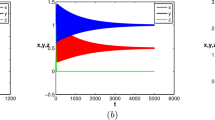Abstract
The predator-prey model is powerful mathematical tool to describe the dynamics of biological systems and promote research on biological populations. In this paper, we present a lumped mass finite element method for solving the predator-prey models on surfaces. The main purpose of the proposed method is to overcome the difficulty of the positivity preservation of the solutions. Based on positivity preservation results, we investigate the stabilities of semi-discrete and fully discrete approximations. Besides, numerical simulations are considered to illustrate the feasibility of the numerical method by convergence tests. Two classical phenomena of the predator-prey model are simulated on three different implicit surfaces.




Similar content being viewed by others
References
Komeil N, Masoud S (2017) Dynamic analysis of fractional-order singular Holling type-II predator-prey system. Appl Math Comput 313:159–179
Javidi M, Nyamoradi N (2014) Dynamic analysis of a fractional order prey-predator interaction with harvesting. Appl Math Model 37:20–21
Diele F, Garvie MR, Trenchea C (2017) Numerical analysis of a first-order in time implicit-symplectic scheme for predator-prey systems. Comput Math Appl 74:948–961
Lotka A (1925) Elements of physical biology. Williams and Wilkins, Baltimore
Volterra V (1926) Variazioni e fluttuazioni del numero di individui in specie animali conviventi. Mem Acad Lincei 2:31–113
Murray J (2002) Mathematical biology I: an introduction. Springer, New York
Holling CS (1959) Some characteristics of simple types of predation and parasitism. Can Entomol 91:385–398
Sherratt JA, Eagan B, Lewis M (1997) Oscillations and chaos behind predator-prey invasion: mathematical artifact or ecological reality. Philos Trans Biol Sci 352:21–38
Sherratt JA (2010) Periodic travelling waves in cyclic predator-prey systems. Ecol Lett 4:30–37
Medvinsky AB, Petrovskii SV, Tikhonova IA (2002) Spatiotemporal complexity of plankton and fish dynamics. Siam Rev 44:311–370
Smoller J (1983) Shock waves and reaction-diffusion equations, Grundlehren der mathematischen Wissenschaften. Springer, New York
Garvie MR, Burkardt J, Morgan J (2015) Simple finite element methods for approximating predator-prey dynamics in two dimensions using Matlab. Bull Math Biol 77:548–578
Chen CM, Thomée V (1985) The lumped mass finite element method for a parabolic problem. ANZIAM J 26:329–354
Garvie MR (2007) Finite-difference schemes for reaction-diffusion equations modeling predator-prey interactions in MATLAB. Bull Math Biol 69:931–956
Dimitrov DT, Kojouharov HV (2008) Nonstandard finite-difference methods for predator-prey models with general functional response. Math Comput Simul 78:1–11
Bairagi N, Biswas M (2016) A predator-prey model with Beddington–DeAngelis functional response: a non-standard finite-difference method. J Differ Equ Appl 22:581–593
Liao W, Zhu J, Khaliq AQM (2002) An efficient high-order algorithm for solving systems of reaction-diffusion equations. Numer Methods Partial Differ Equ 18:340–354
Gu Y, Liao W, Zhu J (2003) An efficient high-order algorithm for solving systems of 3-D reaction-diffusion equations. J Comput Appl Math 155:1–17
Dziuk G, Elliott CM (2013) Finite element methods for surface PDEs. Acta Numer 22:289–396
Xiao X, Feng X, He Y (2019) Numerical simulations for the chemotaxis models on surfaces via a novel characteristic finite element method. Comput Math Appl 78:20–34
Xiao X, Feng X, Li Z (2019) A gradient recovery-based adaptive finite element method for convection–diffusion-reaction equations on surfaces. Int J Numer Methods Eng 120:901–917
Xiao X, Wang K, Feng X (2018) A lifted local Galerkin method for solving the reaction-diffusion equations on implicit surfaces. Comput Phys Commun 231:107–113
Shankar V, Wright GB, Kirby RM (2015) A radial basis function (RBF)-finite difference (FD) method for diffusion and reaction-diffusion equations on surfaces. J Sci Comput 63:745–768
Fuselier EJ, Wright GB (2013) A high-order kernel method for diffusion and reaction-diffusion equations on surfaces. J Sci Comput 56:535–565
Cécile P (2012) The orthogonal gradients method: a radial basis functions method for solving partial differential equations on arbitrary surfaces. J Comput Phys 231:4662–4675
Zhao F, Li J, Xiao X (2019) The characteristic RBF-FD method for the convection–diffusion-reaction equation on implicit surfaces. Numer Heat Transf Part A Appl 75:548–559
Huang X, Xiao X, Zhao J, Feng X (2019) An efficient operator-splitting FEM-FCT algorithm for 3D chemotaxis models. Eng Comput 35:1–12
Xiao X, Feng X, Yuan J (2018) The lumped mass finite element method for surface parabolic problems: error estimates and maximum principle. Comput Math Appl 76:488–507
Dziuk G (2007) Surface finite elements for parabolic equations. J Comput Math 25:385–407
Thomée V (1984) Galerkin finite element methods for parabolic problems. Springer, Berlin
Brenner S, Scott R (2007) The mathematical theory of finite element methods. Springer Science and Business Media, New York
Dubois DM (1975) A model of patchiness for prey-predator plankton populations. Ecol Model 1:67–80
Acknowledgements
The authors would like to thank the editor and referees for their valuable comments and suggestions which helped us to improve the results of this article. This work is in parts supported by the NSF of China (No. U19A2079, No. 11671345, No. 61962056, No. 11971377), the Xinjiang Provincial University Research Foundation and the NSF of Shanxi Province (No. 2019JM-367).
Author information
Authors and Affiliations
Corresponding author
Additional information
Publisher's Note
Springer Nature remains neutral with regard to jurisdictional claims in published maps and institutional affiliations.
Rights and permissions
About this article
Cite this article
Zhang, M., Xiao, X. & Feng, X. Numerical simulations for the predator-prey model on surfaces with lumped mass method. Engineering with Computers 37, 2047–2058 (2021). https://doi.org/10.1007/s00366-019-00929-4
Received:
Accepted:
Published:
Issue Date:
DOI: https://doi.org/10.1007/s00366-019-00929-4
Keywords
- Predator-prey model
- Lumped mass method
- Surface finite element method
- Stability analysis
- Positivity preservation




